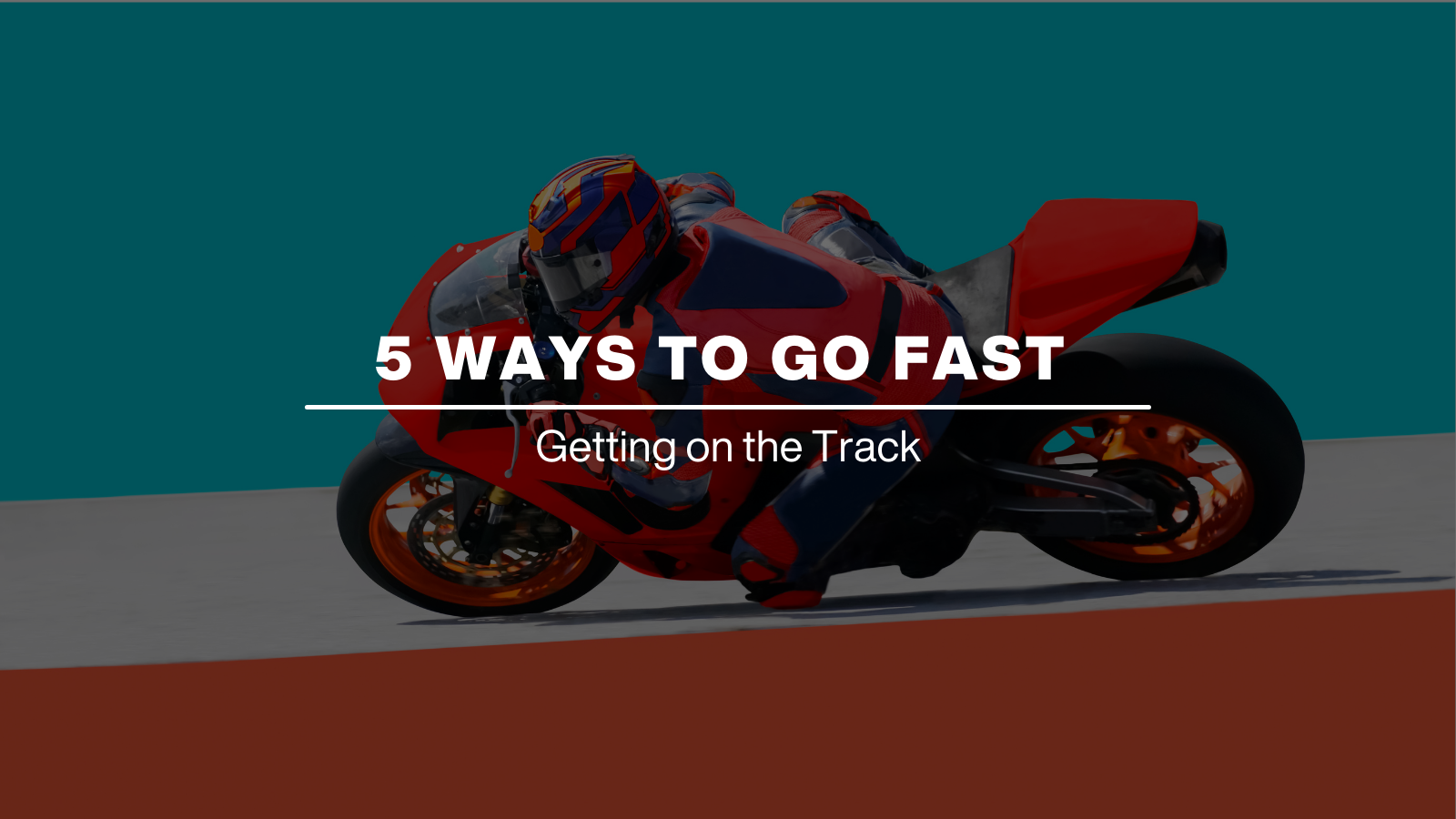Let's be honest: we like motorcycles because they're fast, and as evidence we submit the fact that there are very few motorcycles sold in the United States that lack the ability to go way faster than the speed limit.
In fact, most motorcycles sold can do better than 110 mph, which in most states is a good way to spend the weekend eating bologna sandwiches and waiting to use the payphone in the county lockup.
But there is a way to go as fast as you dare—legally!
We're talking trackdays, and even though there's some kind of organized closed-course racing or practice within 100 miles of almost every motorcyclist in the US, most riders never get anywhere near a track. Maybe they think it's too expensive, too dangerous or that they're not “fast” enough to do one.
Well, we can tell you that it’s not, they're not, and you are. Check out 5 ways to have a blast and improve your skills without risking too much of your safety or bank account. And don't forget to take your hearing protection! Motorcycle earplugs are an important part of your motorcycle gear, as they reduce the high-speed wind noise that can wear you down and damage your hearing over time.
1. Roadrace Course Track Days

Wait, don't you have to be a visionary Bitcoin speculator who can afford the latest 200-horsepower superbike, stacks of tires and be willing to slide both ends as you push yourself to your limits to shave another half second off the track record to enjoy trackdays?
No! Of course not! That's racing, while a trackday is a place where you can practice the skills of your motorcycle—almost any motorcycle—in a safe, supportive environment.
Safe? Yes, that's right: trackday organizers put safety in front of everything. All bikes need to be well maintained, riders must wear full protective gear (usually leather but some organizers allow textiles), and corner workers keep a close watch on the track whenever bikes are on it, ready to shut it all down if something goes amiss.
Doing a trackday as a beginner is a fun, safe, and fairly inexpensive experience. You don't need race tires or custom bodywork; just run what ya brung and take advantage of the coaching and other services the provider will offer.
Riders in the entry-level group (usually called “C”) generally ride at what would be a fast street pace, but with smooth pavement, a known set of curves and no cross-traffic, animals or other distractions they can work on their lines, making them smoother and dare we say safer on the next street ride.
Go here for a list of track-day providers.
2. Supermoto

Photo: Creative Commons
If your beard (or your head) has more gray than not, you may remember ABC's Wide World of Sports.
Back in 1979, the network sponsored a new sport called Superbikers, a test of the world's fastest motorcycle racers. Motocross-style bikes were wedded with roadracing suspension, brakes and tires. Then the racers, champions of roadracing, motocross and flat track, were turned loose on a part-pavement part-dirt circuit to see who would be the...Superbiker!
Sounds exciting, and it did well in the ratings, but various glitches brought it to a close in 1985. By the end of the 1980s, manufacturers like KTM and Yamaha were introducing street-legal, turn-key models and the first national races held in 2003. Today, it's a thriving community, with dozens of race organizations (including the AMA), factory teams and thousands of amatuer racers and enthusiasts sliding around go-kart tracks around the country.
Just like roadracing, you don't need the latest, fastest machine to get out there on practice days. You don't even need to lace up expensive 17-inch rims; you can get grippy pavement-oriented rubber for just about any dirtbike wheel size.
And you don't need to go fast, either! Find an old TTR-125 or XR100, put on some fresh tires and tubes, give it fresh fork oil and a motor-oil change and find your local Supermoto organization.
You'll find they have race classes for everything from pee-wee 50s to open-class 450cc monsters. They also offer coaching, open practice days (for as cheap as $10 or $20 to ride all day) and a fun, supportive family atmosphere.
Check out these resources for Supermoto fun.
- Socal Supermoto
- SupermotoUSA and AMA SupermotoWest Racing
- OSB Supermoto | Racing | Parts | Lifestyle
- SMEC Supermoto
3. Flat-Track (Dirt Track)

Flat-Track racing is America's original form of two-wheeled powersport and dominated the racing scene until our racetracks started getting paved in the 1950s. The rules are simple: go as fast as you can on a quarter, half or one mile oval covered with hard-packed, clay-like earth.
Oh, but one thing: no front brakes. Racers slow down by pitching the bikes sideways until the front wheel points the right way, then blast down the next straight to do it all over again. It's messy, loud, tiring, raucous...and a lot of fun as the tightly packed riders jockey for position.
And you can do it too! Most flat-track is handled by the AMA (What? You're not a member? Join!), who run both amatuer and professional level race series all over the country.
Like Supermoto, you don't need fancy equipment, as there are classes for all bikes (a friend of ours races a 1999 Yamaha YZF-R1, but this is not normal), ages and skill levels. Check out the AMA website to find out about the racing near you.
If you want to take it slow, you can also sign up for a flat-track school. Some big-name racers like Rich Oliver and TK own these schools, and they generally provide the bikes, gear, food, water and all the instruction you can handle. It's an insane amount of fun, but it will also make you a smoother and safer rider by teaching you a lot about steering dynamics, traction and throttle control.
Here are some Flat-Track Resources:
4. Mini Roadracing/Minimoto

Photo: Creative Commons
If you're thinking this section is about roadracing and supermoto, only smaller, you're correct. “Pocketbike” racing started in Europe decades ago, pitting kids as young as three against each other on tiny two-stroke sportbikes with 6.5-inch wheels.
In fact, it's how most of the current MotoGP and World Superbike grids got their start, and it's tough to be competitive as an adult if your 20-year-old fellow racers have been dragging their knees for 15 years!
If you want to get your kids into racing—or enjoy a sport that's affordable and as fun as anything you can do legally—racing or just practicing with a mini is perfect. A mini roadracer can be had for well under $500; buy a dozen and start your own racing league in an abandoned parking lot.
Mini Roadracing Resources:
5. Motorcycle Gymkhana
Here's a way to utilize extreme motorcycle skill in a very low-speed, inexpensive manner. Invented in Japan, M-Gymkhana is a timed solo event where riders learn and navigate a very tight, low-speed road course. The lowest time wins, and just about any motorcycle can be used.
This video blew our minds when we watched it:
It's not as popular as other kinds of pavement competition, with only one organization hosting competition events, but M-Gymkhana events seem to pop up sporadically at motorcycle shows, club rallies and other events. In fact, it's easy to organize on your own, with lots of online resources. If you've ever tried it, you'll know it can be challenging, fun and addictive.
Motorcycle Gymkhana Resources:




Share:
HOW TO FIND THE BEST MOTORCYCLE GLOVES FOR YOU
MOTORCYCLE & MISFITS: FIVE QUESTIONS WITH LIZA MILLER